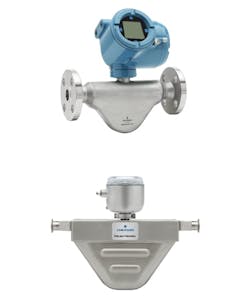Advanced Coriolis transmitter capabilities now available
Coriolis flowmeters are generally considered to be the best option when mass flow and density measurement are required, as compared to other flow measurement technologies. Their ability to measure true mass independent of density and temperature variation is invaluable in raw material charging, custody transfer, product filling and other applications.
There have been a multitude of improvements in Coriolis sensors and transmitters over the years, but new Coriolis transmitters provide a wider array of housing, I/O and software options. These transmitters are also sold with tiered pricing, empowering users to pick, choose and pay for only the specific options needed for their application.
Coriolis meter advantages and limitations
Most flowmeters measure mass flow indirectly. By measuring differential pressure across a restriction or the fluid response to a magnetic field or ultrasonic signal, the meter calculates fluid velocity and converts that to mass flow based on assumptions of pressure, temperature, and density. Such volumetric-based mass flow measurement can have significant errors as process conditions or fluid products change.
Coriolis meters measure true mass flow, density and temperature directly. This eliminates any guesswork on unit conversions, and it provides a consistent and reliable measurement, regardless of variable process conditions. Such a measurement is far preferred for applications where high accuracy is paramount, especially when process conditions are subject to significant changes.
These same measured signals can also be utilized to calculate many other related variables, such as gas void fraction, acid/base concentration and others. Coriolis meters can also measure both gas and liquid mass flow, a capability few flow measurement devices can match.
While Coriolis sensors have seen steady refinements in accuracy and reduced sensor size, transmitters have improved at a relatively slower speed. The I/O options have historically been somewhat limited and fixed, there were few integrated communication alternatives, and the housing options were restricted. In response, manufacturers have designed new Coriolis transmitter models that address these limitations, while providing other benefits.
Coriolis transmitter hardware improvements
The latest Coriolis transmitter designs have expanded available options significantly in terms of the housing, inputs and outputs (I/O), and software. Additional I/O as well as advanced software features can be added either during the initial order or after installation, allowing users to purchase only the features they need, and to then upgrade if and when required.
The changes start with the transmitter housing. Coriolis transmitters can be integral or remote- mounted, include a touch display or be blind, and be specified in a standard epoxy painted aluminum or hygienic versions (Figure 1).
Regardless of the housing option chosen, all the designs are significantly smaller and weigh much less than previous versions. When paired with a next- generation Coriolis sensor (Figure 2), the lightweight transmitter/sensor combination has about one quarter the form factor of previous designs, making it ideal for skid assemblies and other tight installations.
The housing has an electrical classification rating of Class 1 Div 2, and it is more cost effective than previous transmitter offerings.
The transmitter’s I/O is now configurable and selectable, and it offers several digital communication protocols. Options include:
- HART mA version, which includes a HART-enabled 4-20mA channel, with an optional second I/O channel that can be a discrete output or frequency output. This version can accept either 120VAC or 24VDC power.
- RS-485 version, which includes an RS-485 channel that communicates via Modbus RTU. It also has an optional second I/O channel that can be a discrete output or frequency output. This version can accept either 120VAC or 24VDC power.
- Ethernet version, which includes an Ethernet channel communicating via Modbus TCP or Ethernet IP, as well as an optional second I/O channel that can be configured as an analog output, discrete output or frequency output. This version can either be powered over Ethernet or with 24VDC.
If the second I/O channel is unnecessary, the transmitter can be ordered with that channel disabled to reduce cost. However, if the channel is required in the future, a license can be purchased, and the channel can then be enabled via a software download.
The new transmitter is compatible with a wide range of Coriolis sensors, including Emerson’s Micro Motion ELITE, F, G, H, R, T and HPC series. Retrofit kits are available to upgrade from an existing Micro Motion 1700 or 2700 transmitter to the 1600 transmitter by simply replacing the existing unit and installing a new cable. This allows an existing legacy sensor to be upgraded to take advantage of the advanced diagnostics and measurement features now available in the newest Coriolis transmitters.
An integral USB-C port allows the transmitter to be easily configured or backed up, and a Bluetooth connectivity option will be available soon.
Coriolis transmitter software improvements
The numerous hardware improvements enable a broad selection of connectivity options, but the software advancements set the latest generation of Coriolis transmitters further apart. Like the hardware, many of the software packages are available as separate selectable options that can be ordered initially or added in the future. These features include:
- Smart Meter Verification software allows the user to fully test and validate meter performance without taking the transmitter off-line. Basic Smart Meter Verification functionality is included, but scheduled and continuous tests and verification reports require the advanced verification license.
- Fast Fill software is specifically designed for very small, very fast, sub-second fill applications. This feature includes automatic overshoot compensation and self-training features.
- Batch software provides single stage batch functions, automatic overshoot compensation and batch ticket reports.
- Concentration measurement software uses the transmitter’s density and temperature readings to calculate °Brix, °Plato, °Balling, °Baume, %HFCS, %HNO3, %NaOH and other concentration measurements.
- Advanced Phase Measurement software detects and measures entrained air and gas void fraction, and it provides several gas/oil/water mixture measurements.
- API referral software calculates relative density, volume corrected to reference temperature and pressures, and flow-weighted average temperature and density, all per API standards.
- PLC Integration Add On instructions are provided to easily incorporate the Coriolis transmitter into an Ethernet network.
- Web-server capability provides secure connectivity to the transmitter ion from any device capable of hosting a web browser, such as a laptop, smartphone or tablet.
- Incorporates a fast and slow data historian with a real-time embedded clock. The fast historian can save up to seven days of data stored at one second intervals. The slow historian can save up to one month of data stored at five-minute intervals.
Conclusion
Coriolis mass flowmeters are well known for their ability to provide very accurate mass flow measurement, and they are the de facto standard for custody transfer, product filling, raw material charging and many other challenging applications. While the Coriolis sensor design has advanced significantly, the options for Coriolis transmitters were more limited.
This situation has improved with the latest generation of Coriolis transmitters. These devices now offer a broad range of configurable I/O and communication protocol options housed in several different styles. Despite the reduced size and cost, the new transmitters have significantly increased processing power, allowing them to perform a host of new and advanced software functions and measurements.
Most of these features are available with tiered pricing, allowing users to pick and choose the appropriate configuration for their application and budget. The latest models also offer retrofit kits, empowering users to take advantage of all the latest features, while leaving the existing sensor installed in the process, with no piping modifications required.
These new capabilities and configuration options have made Coriolis technology an even stronger measurement alternative for a wider range of applications. When considering an existing or new potential Coriolis meter application, users should investigate the latest Coriolis transmitter options, consulting with their supplier as required.
About the Author

Kelly Albano
Product manager for Emerson Coriolis transmitters and software at Emerson
Kelly Albano has been with Emerson for over 12 years and is a product manager for Emerson Coriolis transmitters and software. She is focused on improving user experiences and guiding users through digital transformations. Albano holds an undergraduate degree in Environmental Engineering from University of Colorado at Boulder, and an MBA with a Marketing Management Certificate from Colorado State University.

